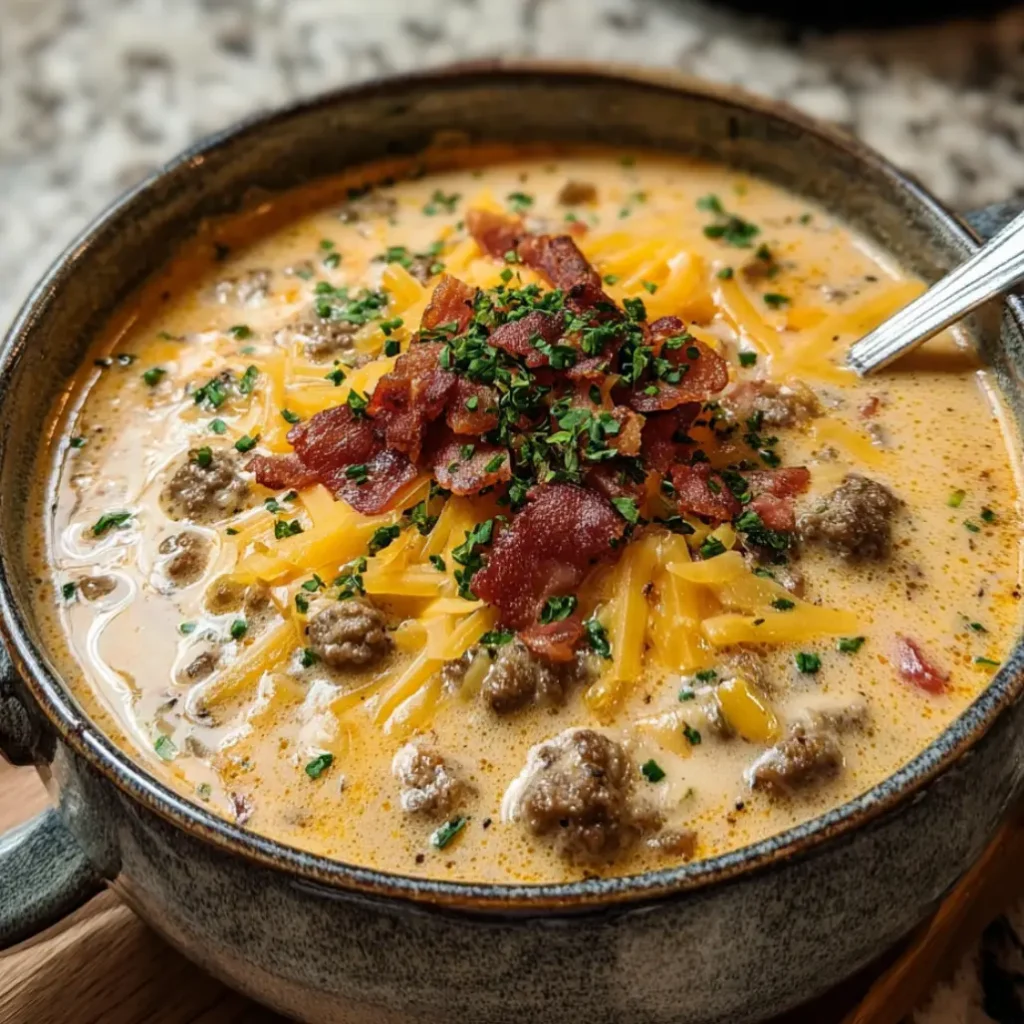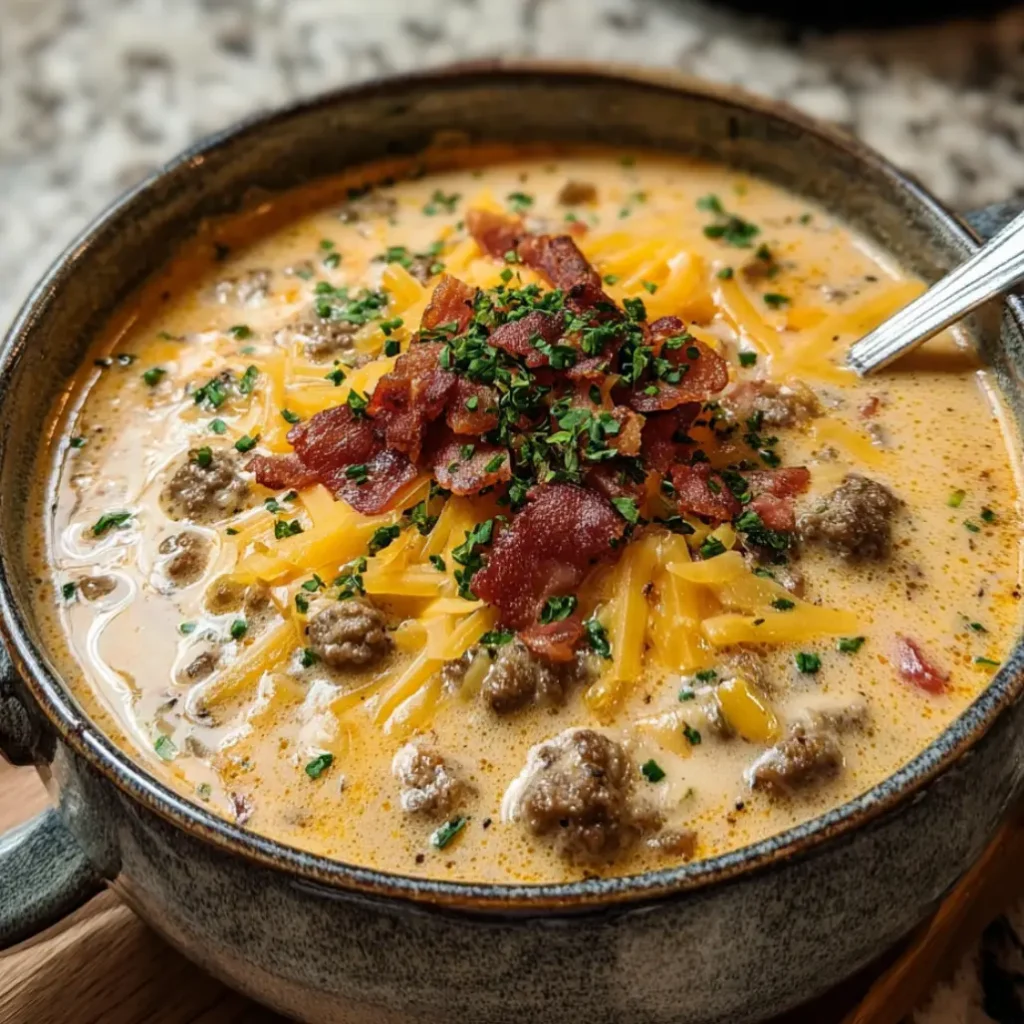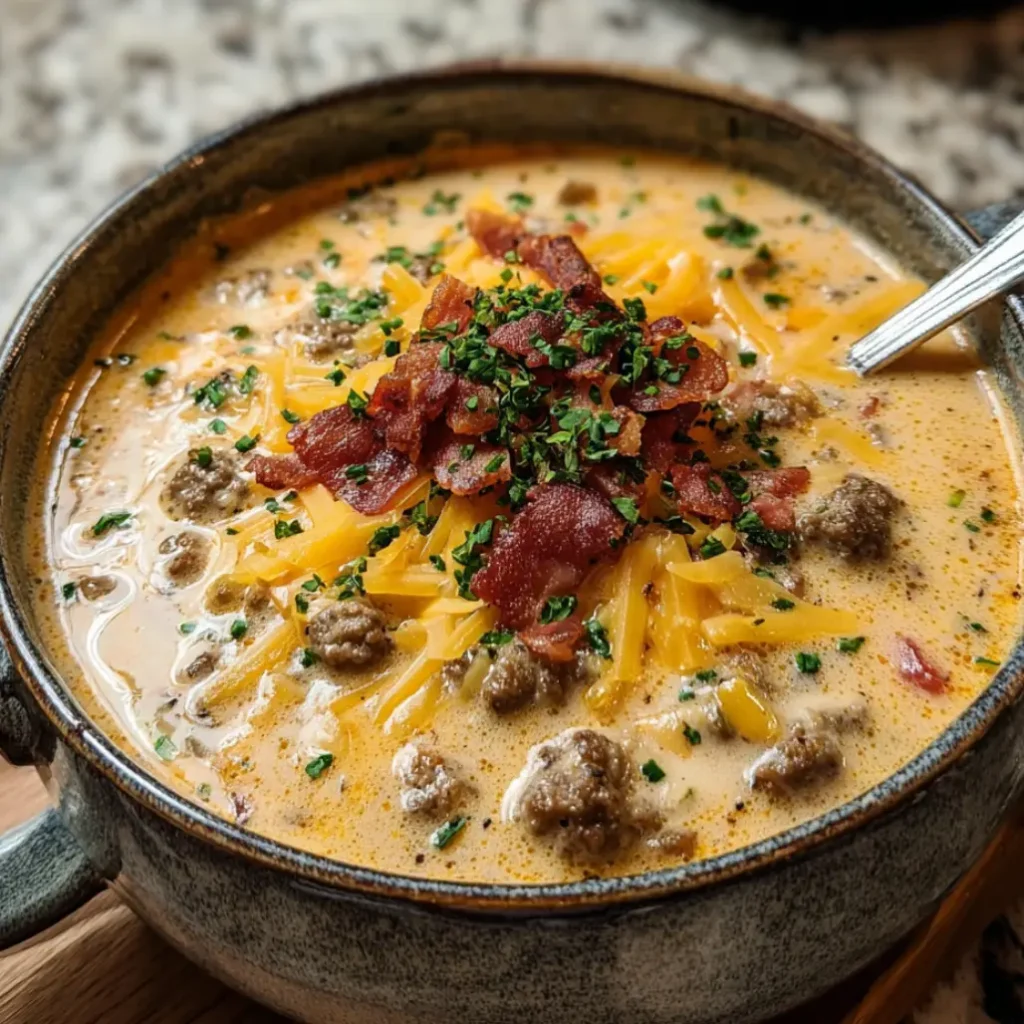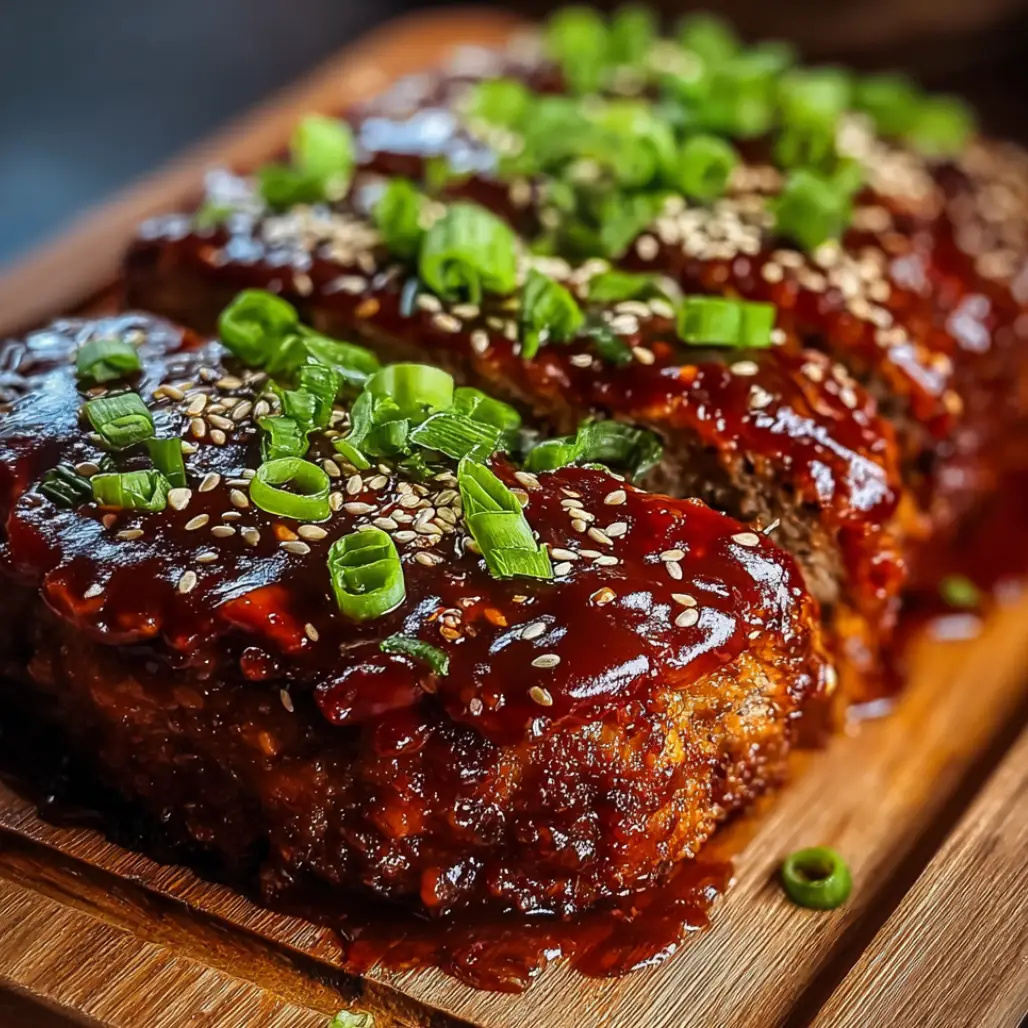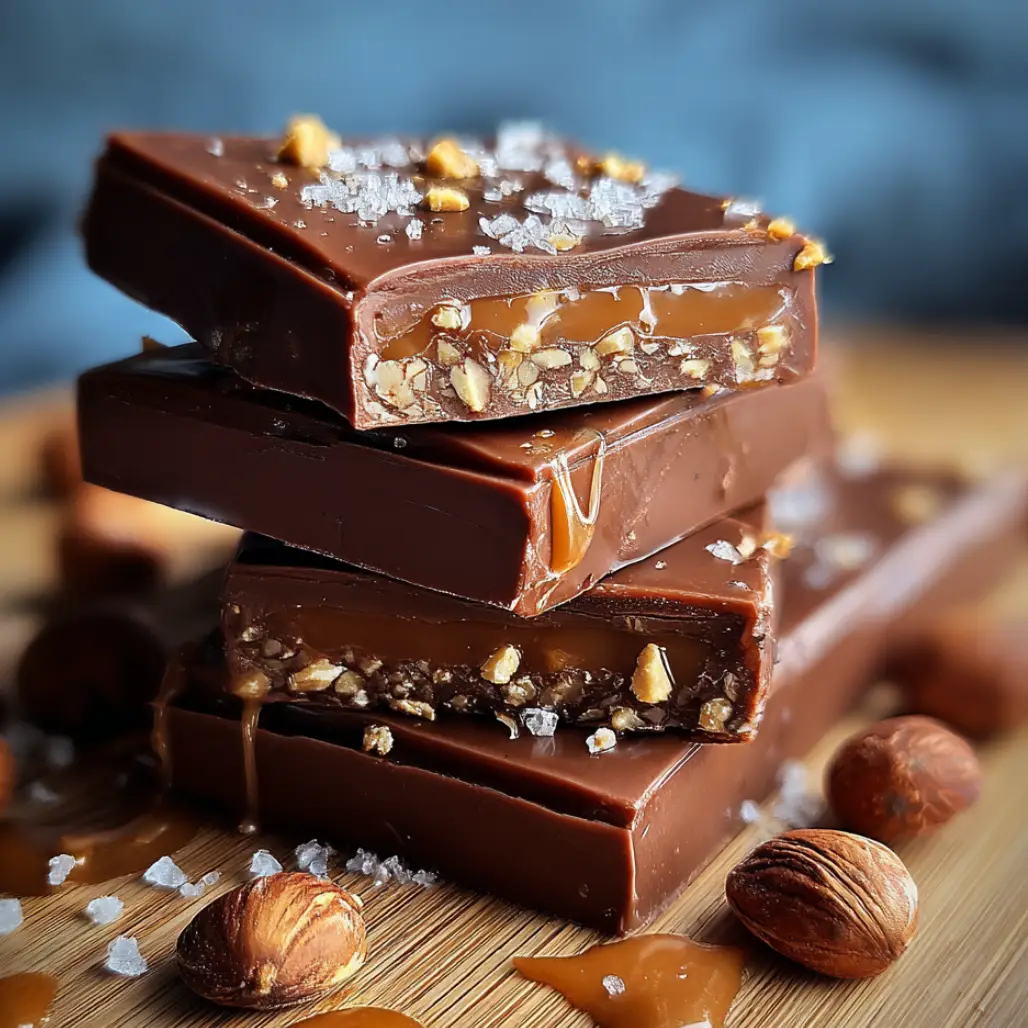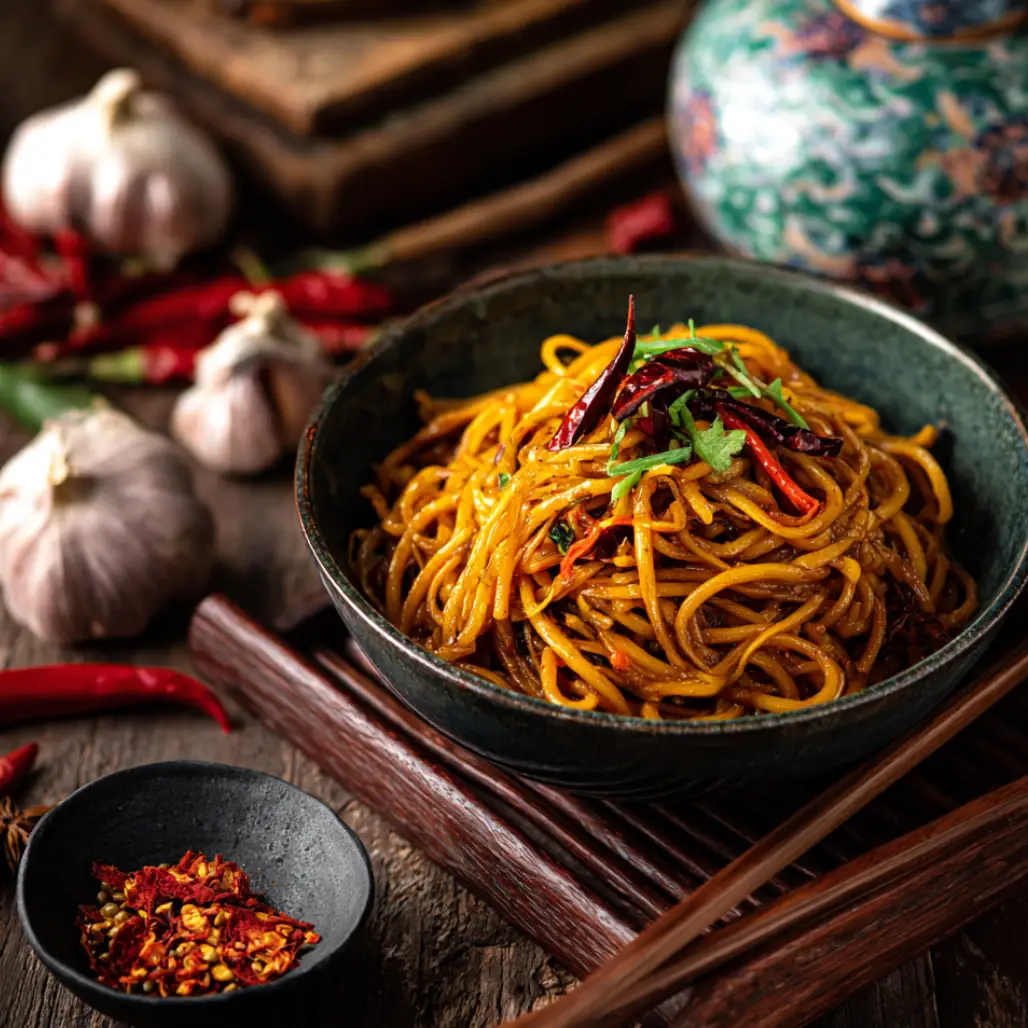| Prep Time: | 15 minutes |
|---|---|
| Cook Time: | 35 minutes |
| Total Time: | 50 minutes |
| Serves: | 8 |
There’s something absolutely magical about transforming the beloved flavors of a classic cheeseburger into a soul-warming bowl of comfort that captures every delicious element you crave because this easy cheeseburger soup delivers all the satisfaction of your favorite burger without the need for grilling or assembling. The rich, creamy broth embraces tender chunks of seasoned ground beef, perfectly cooked potatoes, and crisp vegetables while melted cheese creates that irresistible indulgence that makes every spoonful feel like a warm hug on a cold day because comfort food should always taste this extraordinary and bring families together around the dinner table.
Why This Easy Cheeseburger Soup Works
This remarkable soup succeeds because it masterfully balances all the classic burger elements in liquid form, creating a harmonious blend where each ingredient enhances the others without overwhelming your palate because the secret lies in building layers of flavor that develop throughout the cooking process. The ground beef provides that essential meaty foundation that burger lovers crave, while the combination of sautéed vegetables adds depth and texture that keeps every bite interesting because monotonous soups simply don’t satisfy the way this complex yet approachable recipe does.
The cheese component transforms ordinary broth into something luxurious and satisfying because melted cheese creates the creamy richness that makes this soup feel indulgent rather than simply nutritious. Meanwhile, the potatoes add heartiness and substance that turns this from a light starter into a complete meal because filling soups should leave you satisfied rather than searching for additional food to complete your dinner experience.
Essential Ingredients
For the Soup Base:
- 1 pound lean ground beef (80/20 blend works perfectly)
- 1 medium yellow onion, finely diced
- 3 medium carrots, diced into small cubes
- 3 celery stalks, diced into small pieces
- 3 medium russet potatoes, peeled and cubed
- 3 tablespoons unsalted butter
- 3 tablespoons all-purpose flour
- 4 cups low-sodium chicken broth
- 2 cups whole milk
- 1 teaspoon dried basil
- 1 teaspoon dried parsley flakes
- 1/2 teaspoon garlic powder
- 1/2 teaspoon salt (or to taste)
- 1/4 teaspoon black pepper
For the Cheese and Creaminess:
- 12 ounces Velveeta cheese, cubed into small pieces
- 1/2 cup sour cream, at room temperature
- 1/4 teaspoon paprika
For Garnish and Serving:
- 1 cup sharp cheddar cheese, shredded
- 4 green onions, thinly sliced
- 6 strips bacon, cooked crispy and crumbled (optional)
- Fresh parsley, chopped for color
The Art of Creating Perfect Easy Cheeseburger Soup
Mastering this easy cheeseburger soup requires understanding that each step builds upon the previous one to create complex flavors from simple ingredients because rushed cooking produces flat, one-dimensional results that don’t capture the magic this recipe can deliver. The key lies in proper browning of the ground beef because this Maillard reaction creates rich, savory notes that form the foundation for everything that follows, while the careful sautéing of vegetables develops their natural sweetness that balances the richness of the cheese and cream.
Temperature control throughout the cooking process ensures smooth, velvety texture because rapid temperature changes can cause the dairy components to curdle or separate, resulting in an unappetizing appearance that doesn’t match the incredible flavor potential. The roux technique, which involves cooking flour and butter together before adding liquids, creates the perfect thickening base that prevents the soup from becoming too thin or developing an unpleasant flour taste because properly cooked flour adds body without compromising the clean, pure flavors that make this dish so appealing.
Step-by-Step Instructions
Step 1: Brown the Ground Beef Heat a large, heavy-bottomed Dutch oven or soup pot over medium-high heat, then add the ground beef and cook while breaking it into small, uniform crumbles using a wooden spoon or spatula because consistent-sized pieces ensure even cooking and better texture in the finished soup. Continue cooking for 6-8 minutes until the beef is completely browned with no pink remaining because properly cooked meat provides the best flavor and food safety, while the fond (browned bits) that develop on the bottom of the pot will add incredible depth to your soup base.
Professional Tip: Don’t overcrowd the pan if doubling the recipe because overcrowded meat steams rather than browns, which prevents the development of those crucial flavor compounds that make the difference between good and exceptional soup.
Key Points: The beef should be uniformly browned with visible caramelization and the fat should be mostly rendered out, creating a flavorful base for building the remaining soup components.
Step 2: Drain and Set Aside the Beef Remove the cooked ground beef using a slotted spoon and transfer it to a plate lined with paper towels to drain excess grease because removing unnecessary fat prevents the soup from becoming greasy while still retaining the essential beef flavors that make this recipe so satisfying. Reserve approximately 2 tablespoons of the rendered fat in the pot because this flavorful fat will enhance the sautéing of vegetables and add richness to the overall dish without making it overwhelming.
Professional Tip: If your ground beef produces excessive grease, drain it completely and add 1 tablespoon of olive oil back to the pot because you want enough fat to sauté the vegetables properly without making the soup greasy.
Key Points: The drained beef should appear dry on the surface while maintaining its moisture internally, and the remaining fat in the pot should be clear and hot, ready for the next cooking stage.
Step 3: Sauté the Aromatic Vegetables Add the diced onion, carrots, and celery to the same pot with the reserved fat, stirring to coat all pieces evenly because well-coated vegetables caramelize more effectively and develop deeper flavors that enhance the overall soup complexity. Sprinkle with basil, parsley, garlic powder, salt, and pepper, then cook for 8-10 minutes, stirring occasionally, until the vegetables begin to soften and the onions become translucent because properly cooked vegetables provide sweetness and texture that balances the richness of the cheese and cream components.
Professional Tip: Cut all vegetables into uniform sizes, approximately 1/4-inch pieces, because consistent sizing ensures even cooking and creates an appealing presentation where every spoonful contains perfectly textured vegetables.
Key Points: The vegetables should be tender-crisp with the onions translucent and slightly golden, while the celery and carrots should yield slightly to pressure but maintain their shape and structural integrity.
Step 4: Add Potatoes and Build the Base Stir in the cubed potatoes along with the cooked ground beef, mixing gently to distribute everything evenly because proper distribution ensures that each serving contains balanced proportions of all ingredients. Pour in the chicken broth and bring the mixture to a rolling boil over medium-high heat because the vigorous bubbling helps break down the potato surfaces slightly, which will help thicken the soup naturally as it cooks.
Professional Tip: Choose russet potatoes because their high starch content helps thicken the soup naturally while maintaining good texture, unlike waxy potatoes that might become gummy or fall apart completely during the long cooking process.
Key Points: The mixture should reach a full boil within 5-7 minutes, and the potatoes should be completely submerged in liquid to ensure even cooking throughout the simmering process.
Step 5: Simmer Until Potatoes are Tender Reduce the heat to medium-low and cover the pot, allowing the soup to simmer gently for 10-12 minutes until the potatoes are fork-tender because properly cooked potatoes should yield easily to pressure while maintaining their shape and contributing to the soup’s hearty character. Stir occasionally to prevent sticking and ensure even cooking because unattended soup can develop hot spots that cause uneven textures and potentially burned flavors that would compromise the final result.
Professional Tip: Test potato doneness by piercing the largest pieces with a fork because if the fork slides in easily without resistance, the potatoes are ready to proceed to the next step, but undercooked potatoes will create an unpleasant texture in the finished soup.
Key Points: The soup should be gently bubbling rather than rapidly boiling, and the potatoes should be completely tender throughout while the other vegetables maintain their distinct textures and flavors.
Step 6: Create the Thickening Roux In a small saucepan, melt the butter over medium heat, then whisk in the flour constantly to prevent lumps from forming because a smooth roux is essential for creating the perfect soup consistency without any unpleasant grittiness. Continue cooking the roux for 3-5 minutes, whisking continuously, until it becomes golden and fragrant because properly cooked flour eliminates the raw flour taste that would otherwise compromise the finished soup’s flavor profile.
Professional Tip: The roux should bubble actively while cooking because this bubbling indicates that the flour is cooking properly and will effectively thicken the soup without creating lumps or leaving an uncooked flour taste.
Key Points: The finished roux should be smooth, golden in color, and smell nutty rather than floury, indicating that the flour has been properly cooked and will integrate seamlessly into the soup base.
Step 7: Incorporate the Roux and Thicken Add the hot roux to the simmering soup gradually, stirring constantly to ensure smooth incorporation because adding it too quickly can create lumps that are difficult to eliminate from the finished soup. Bring the mixture back to a gentle boil and cook for 2-3 minutes while stirring frequently because this final cooking step activates the thickening properties of the flour and creates the perfect consistency for adding dairy ingredients.
Professional Tip: Use a whisk rather than a spoon to incorporate the roux because whisking action helps break up any potential lumps and ensures the smoothest possible texture in your soup base.
Key Points: The soup should thicken noticeably within 2-3 minutes of adding the roux, and the consistency should coat the back of a spoon while still being pourable and smooth throughout.
Step 8: Add Milk and Reduce Heat Reduce the heat to low and gradually stir in the milk, adding it slowly while stirring constantly because rapid temperature changes can cause the milk to curdle and create an unappetizing texture that cannot be corrected. Allow the soup to heat through gently for 3-4 minutes without boiling because boiling dairy can cause curdling and separation that would ruin the smooth, creamy texture that makes this soup so appealing.
Professional Tip: Warm the milk slightly before adding it to the soup because cold milk added to hot soup creates a greater temperature differential that increases the risk of curdling and texture problems.
Key Points: The soup should steam gently but never bubble vigorously, and the milk should integrate smoothly without any signs of curdling or separation that would indicate temperature shock.
Step 9: Melt in the Cheese Remove the soup from heat completely and gradually stir in the cubed Velveeta cheese, adding it handful by handful while stirring constantly because off-heat addition prevents the cheese from seizing or becoming stringy. Continue stirring until all cheese is completely melted and the soup achieves a smooth, creamy consistency because properly melted cheese creates the luxurious texture that defines this comforting soup.
Professional Tip: Cut the Velveeta into small, uniform cubes before adding because smaller pieces melt more quickly and evenly, reducing the risk of overheating and creating a smooth, professional-quality finish.
Key Points: The cheese should melt completely without any visible lumps or strings, and the soup should have a rich, creamy appearance with a smooth, velvety texture throughout.
Step 10: Finish with Sour Cream Stir in the sour cream and paprika while the soup is still off the heat because adding dairy to hot soup can cause curdling that would compromise both texture and appearance. Mix gently but thoroughly until the sour cream is completely incorporated and the soup has a uniform, creamy appearance because proper integration of the sour cream adds tanginess that balances the richness while contributing to the overall creamy mouthfeel.
Professional Tip: Allow the sour cream to come to room temperature before adding because cold sour cream is more likely to curdle when added to hot soup, even when the pot is off the heat.
Key Points: The finished soup should be completely smooth with no visible streaks of sour cream, and the color should be uniform throughout with a rich, creamy appearance that looks professionally prepared.
Professional Tips for Success
Understanding the science behind each technique ensures consistent results every time you prepare this easy cheeseburger soup because cooking is fundamentally about controlling reactions and processes that transform simple ingredients into extraordinary comfort food. Room temperature dairy ingredients integrate more smoothly because temperature differentials can cause proteins to coagulate and create undesirable textures, while gradual heating allows proteins to denature slowly and maintain their creamy characteristics.
The vegetable preparation significantly impacts the final result because uniformly cut vegetables cook evenly and create a professional appearance that makes every bowl look appetizing. For additional meal planning inspiration, explore our collection of perfect sides that complement hearty soups, or discover options from our salads section for lighter accompaniments that balance rich, creamy soups.
Proper seasoning throughout the cooking process builds complex flavors because adding seasonings at different stages allows them to develop and meld rather than simply sitting on top of the finished dish. This layered approach to seasoning creates depth that distinguishes restaurant-quality results from basic home cooking because professional chefs understand that timing matters as much as ingredient quality in creating memorable dishes.
Creative Variations to Explore
Transform this basic recipe into exciting variations by incorporating different proteins or vegetables that maintain the essential cheeseburger character while adding your own creative touches because adaptation allows you to customize the soup to personal preferences and dietary needs. Consider substituting ground turkey or chicken for a lighter version because these leaner proteins still provide satisfying substance while reducing overall fat content, or try a combination of ground beef and Italian sausage because the additional spices create a more complex flavor profile.
Vegetable variations can completely change the character of your easy cheeseburger soup because different vegetables contribute unique flavors and textures that keep the recipe interesting through multiple preparations. Add diced bell peppers for sweetness and crunch, incorporate mushrooms for earthiness, or include corn for a touch of sweetness because these additions maintain the comfort food appeal while adding nutritional value and visual interest.
For those seeking lighter options to balance this rich soup, consider browsing our snacks appetizers collection for smaller plates that can start the meal. Cheese variations also offer exciting possibilities because different cheese types create distinct flavor profiles while maintaining the creamy texture that defines this soup, so experiment with sharp cheddar, pepper jack, or even a combination of cheeses for unique results.
Perfect Pairing Ideas
This hearty, rich soup pairs beautifully with lighter accompaniments that provide textural contrast and help balance the indulgent nature of the cheese and cream components because successful meal planning considers how different elements work together to create satisfying dining experiences. Crusty bread or warm dinner rolls offer the perfect vehicle for soaking up every drop of the creamy broth because bread provides the satisfying carbohydrate component that makes soup feel like a complete meal rather than just an appetizer.
Fresh, crisp salads create excellent contrast against the richness of this easy cheeseburger soup because the acidity and crunch of fresh vegetables help cleanse the palate between spoonfuls while providing nutritional balance that makes the overall meal feel more complete. Consider exploring our refreshing beverages section for drink options that complement hearty soups without competing with their flavors.
For wine enthusiasts, light red wines or crisp white wines provide elegant pairing options because the acidity helps cut through the richness while the alcohol enhances the savory flavors without overwhelming the delicate balance of ingredients. Beer lovers might prefer light lagers or wheat beers because these styles complement comfort food without adding excessive heaviness to an already substantial meal.
Discover More Comfort Food Favorites
Expand your comfort food repertoire by exploring related recipes that share similar techniques or flavor profiles with this easy cheeseburger soup because mastering foundational cooking methods opens doors to countless other satisfying dishes. Our savory sides collection offers numerous options for creating complete comfort food meals that celebrate hearty, satisfying flavors while providing the variety needed for interesting weekly meal planning.
Consider learning to make loaded baked potato soup or broccoli cheese soup because these recipes use similar techniques for creating creamy, satisfying soups that can become regular rotation favorites. The cheese sauce techniques you master while making this soup translate directly to many other comfort food applications because understanding how to work with dairy and cheese opens up endless possibilities for creating indulgent, restaurant-quality dishes at home.
For morning meal inspiration, browse our partner site’s breakfast favorites to discover hearty breakfast options that provide the same satisfying comfort as this soup, allowing you to create cohesive comfort food themes throughout your daily meal planning.
Storage and Make-Ahead Guidelines
Proper storage techniques ensure that your easy cheeseburger soup maintains its delicious flavor and creamy texture for several days after preparation because dairy-based soups require specific handling to prevent spoilage and texture degradation. Store cooled soup in airtight containers in the refrigerator for up to 4 days because the dairy components limit the safe storage time compared to broth-based soups, while proper containers prevent the absorption of refrigerator odors that could affect the delicate flavor balance.
Reheating requires gentle techniques because aggressive heating can cause the dairy components to separate or curdle, creating an unappetizing appearance that doesn’t match the smooth, creamy texture that makes this soup so appealing. Heat refrigerated soup slowly over low heat while stirring frequently because gradual reheating allows the proteins to warm without coagulating, maintaining the original smooth consistency throughout the reheating process.
Freezing this soup is not recommended because both potatoes and dairy components suffer texture changes when frozen and thawed, resulting in a grainy, separated consistency that cannot be restored to its original smoothness. Instead, consider making smaller batches more frequently because fresh soup always delivers better results than previously frozen versions, and the relatively quick cooking time makes frequent preparation practical rather than burdensome.
The Science Behind Perfect Results
Understanding the scientific principles behind this easy cheeseburger soup empowers you to troubleshoot problems and achieve consistent results because each component involves specific reactions that require particular conditions to succeed optimally. The Maillard reaction that occurs during beef browning creates hundreds of flavor compounds that provide the deep, savory notes that distinguish exceptional soup from ordinary versions because this complex chemistry cannot be rushed or simplified without compromising the final result.
Cheese melting involves protein networks that can either create smooth, creamy textures or stringy, separated messes depending on temperature control and technique because heat causes proteins to denature and either reform into smooth gels or coagulate into unappetizing clumps. The gradual heating and off-heat addition techniques prevent protein shock that would otherwise create texture problems that cannot be corrected once they occur.
Starch gelatinization from both the flour roux and potato cooking creates the body and mouthfeel that makes this soup satisfying rather than thin and watery because these carbohydrates absorb liquid and swell to create substance that provides satiety and pleasure. Understanding these processes helps explain why shortcuts rarely work in soup making and reinforces the importance of following proper techniques for optimal results.
Troubleshooting Common Issues
Even experienced cooks occasionally encounter problems with dairy-based soups like this easy cheeseburger soup, but understanding the causes helps you prevent and correct most issues before they affect the final result because many problems develop from easily corrected technique errors rather than fundamental recipe flaws. Curdled or separated dairy typically results from excessive heat or rapid temperature changes because proteins respond to temperature shock by clumping together rather than maintaining their smooth, creamy structure.
If your soup becomes too thick during cooking, gradually add warm milk or broth while stirring gently because thinning should be done slowly to maintain proper consistency without creating a watery texture that lacks the richness this recipe should deliver. Conversely, if the soup seems too thin after following the recipe, create a small slurry of cornstarch and cold milk because this emergency thickening technique can rescue thin soup without affecting the flavor profile.
Grainy texture usually indicates that the flour wasn’t cooked long enough in the roux stage or was added too quickly to the hot liquid because improperly incorporated flour creates unpleasant texture that persists throughout the eating experience. If graininess occurs, strain the soup through a fine-mesh sieve and return it to the pot because this aggressive technique can eliminate texture problems, though prevention through proper technique is always preferable to correction.
Additional Comfort Food Inspirations
Extend your comfort food cooking adventures by exploring recipes that incorporate similar techniques and ingredients because mastering one complex soup opens doors to many related creations that can keep your weekly meal planning interesting and satisfying. Consider loaded potato soup with bacon and chives because it uses similar dairy techniques in a different flavor profile, or explore chicken and dumplings because the thickening methods translate perfectly to creating satisfying, hearty soups.
The cheese sauce techniques you develop while making this soup apply to many other comfort food classics because understanding how to work with dairy and cheese creates foundation skills for everything from macaroni and cheese to au gratin casseroles. You might also explore our collection of flavored dips marinades for appetizer options that can precede hearty soup dinners because complete meal planning considers how different courses work together.
Building a repertoire of soup recipes provides valuable meal planning flexibility because soups can serve as main courses, side dishes, or even appetizers depending on portion sizes and accompaniments. The techniques you master while perfecting this easy cheeseburger soup will serve you well in countless other cooking adventures because fundamental skills like browning, sautéing, and working with dairy form the backbone of successful home cooking across many different cuisines and cooking styles.
Conclusion
This easy cheeseburger soup represents the perfect marriage of comfort and convenience because it delivers all the satisfying flavors of a classic cheeseburger in a format that’s easier to prepare and serve than traditional burgers while providing the soul-warming qualities that make soup such a beloved comfort food category. The rich, creamy base embraces tender vegetables and perfectly seasoned ground beef while melted cheese creates that indulgent quality that transforms simple ingredients into something truly special because exceptional comfort food should always feel like a warm hug in a bowl.
Mastering this recipe builds confidence for tackling other complex soup recipes because the techniques you’ll learn, from proper browning to dairy incorporation, form the foundation for countless other satisfying soups that can elevate your home cooking reputation. The investment in time and attention pays dividends not just in the immediate pleasure of enjoying this incredible soup, but in the skills and knowledge that will serve you well in future culinary adventures because good cooking is fundamentally about understanding how ingredients behave and how techniques affect final results.
Whether you’re preparing this easy cheeseburger soup for a casual family dinner or serving it to guests who appreciate comfort food at its finest, remember that the process itself rewards careful attention to detail because each step builds upon the previous one to create something greater than the sum of its parts. For additional inspiration to round out your comfort food menu, explore our dessert recipes collection because the perfect ending to a hearty soup dinner should be just as satisfying and memorable as the main course itself.

